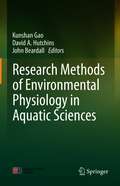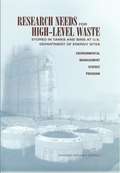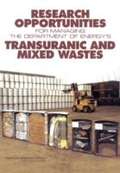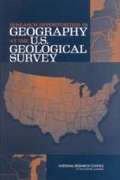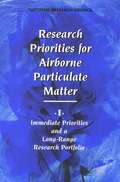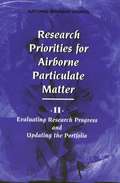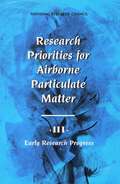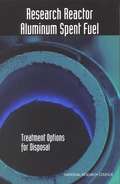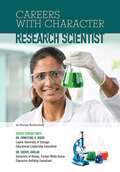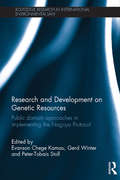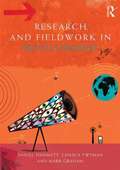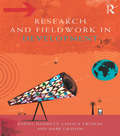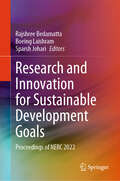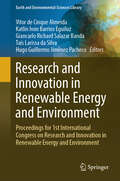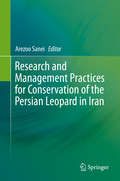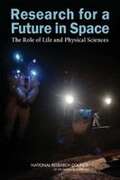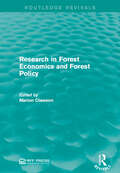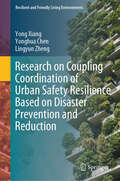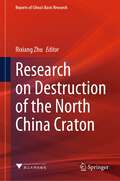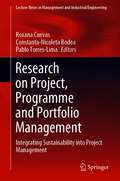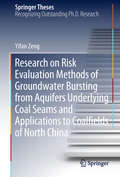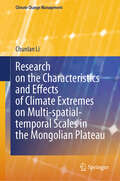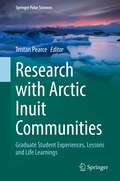- Table View
- List View
Research Methods of Environmental Physiology in Aquatic Sciences
by John Beardall Kunshan Gao David A. HutchinsThis book presents methods for investigating the effects of aquatic environmental changes on organisms and the mechanisms involved. It focuses mainly on photosynthetic organisms, but also provides methods for virus, zooplankton and other animal studies. Also including a comprehensive overview of the current methods in the fields of aquatic physiology, ecology, biochemistry and molecular approaches, including the advantages and disadvantages of each method, the book is a valuable guide for young researchers in marine or aquatic sciences studying the physiological processes associated with chemical and physical environmental changes.
Research Needs For High-level Waste Stored In Tanks And Bins At U.s. Department Of Energy Sites: Environmental Management Science Program
by Committee on Long-Term Research Needs for Radioactive High-level Waste at Department of Energy SitesThe committee was charged to identify high-level waste problems that cannot be addressed effectively with current technologies, and to recommend areas of research by which the Department's Science Program can make significant contributions to solving these problems and adding to scientific knowledge generally. The members were selected for their expertise in various relevant fields. The report is not indexed. Annotation c. Book News, Inc. , Portland, OR (booknews. com)
Research Opportunities For Managing The Department Of Energy's Transuranic And Mixed Wastes
by Committee on Long-Term Research Needs for Managing Transuranic Mixed Wastes at Department of Energy SitesAbout 155,000 cubic meters of waste contaminated with both radioactive isotopes and hazardous chemicals are stored at some 30 DOE sites, and another 450,000 cubic meters are buried. While DOE is making a concerted effort to properly dispose of this waste, the amount translates to a multi-decade effort that will require handling, characterizing, and shipping hundreds of thousands of waste containers at a total cost of billions of dollars. This report describes basic scientific research that can lead to new technologies for performing these tasks more safely and cost effectively.
Research Opportunities In Geography At The U.s. Geological Survey
by Committee on Research Priorities in Geography at the U.S. Geological SurveyResearch Opportunities in Geography at the U.S. Geological Survey (USGS) provides perspective and guidance to the geography discipline about its future research and strategic directions. The book makes specific recommendations about scientific research priorities and partnerships within and outside the agency, and outlines a long-term core research agenda for the USGS.
Research Priorities for Airborne Particulate Matter, Volume I: Immediate Priorities and a Long-Range Research Portfolio
by Committee on Research Priorities for Airborne Particulate MatterNew National Ambient Air Quality Standards for airborne particles smaller than 2.5 micrometers, called PM2.5, were issued by the U.S. Environmental Protection Agency (EPA) amidst scientific uncertainty and controversy. In response to a request from Congress, Research Priorities for Airborne Particulate Matter, the first of four books in a series, offers a conceptual framework for an integrated national program of particulate-matter research, identifies the 10 most critical research needs linked to key policy-related scientific uncertainties, and describes the recommended timing and estimated costs of such research.The committee concludes that EPA should devote more resources to investigating the relationships between fixed-site outdoor monitoring data and actual human breathing-zone exposures to ambient particulate matter and to identifying the most biologically important constituents and characteristics of particulate matter through toxicological studies. The recommended research activities are critical to determining actual exposures of human subpopulations most susceptible to harm from the most hazardous constituents of particulate matter. Future research will be an investment in public health and a means to ensure that resources spent on control technology and regulatory compliance will have a reasonable probability of success.
Research Priorities for Airborne Particulate Matter, Volume II
by Committee on Research Priorities for Airborne Particulate MatterIn the effort to reduce the scientific and technical uncertainties over regulation of airborne particulate matter in the United States, Research Priorities for Airborne Particulate Matter: II. Evaluating Research Progress and Updating the Portfolio, the second book in a four-part series requested by Congress, describes the plans of the committee to monitor the progress of the research on particulate matter conducted by the U.S. Environmental Protection Agency (EPA), other federal and state government agencies, and nongovernmental organizations.The book also reviews and updates the committee's portfolio of recommended research in its first volume, Research Priorities for Airborne Particulate Matter: I. Immediate Priorities and a Long-Range Research Portfolio (NRC, 1998). The committee substantially revised two of the ten high-priority research areas recommended in Part I. Part II notes that Congress, EPA, and the scientific community have given strong support to the committee's recommendations and have implemented substantial changes in research efforts in response to Part I of the series. One important research area-studies of the effects of long-term exposure to particulate matter and other major air pollutants-however, does not appear to be underway or planned.
Research Priorities for Airborne Particulate Matter, Volume III
by Committee on Research Priorities for Airborne Particulate MatterRegulatory standards are already on the books at the the U.S. Environmental Protection Agency (EPA) to address health risks posed by inhaling tiny particles from smoke, vehicle exhaust, and other sources. At the same time, Congress and EPA have initiated a multimillion dollar research effort to better understand the sources of these airborne particles, the levels of exposure to people, and the ways that these particles cause damage. To provide independent guidance to the EPA, Congress asked the National Research Council to study the relevant issues. The result is a series of four reports on the particulate-matter research program. The first two books offered a conceptual framework for a national research program, identified the 10 most critical research needs, and described the recommended timing and estimated costs of such research. This, the third volume, begins the task of assessing the progress made in implementing the research program. The National Research Council ultimately concludes that the ongoing program is appropriately addressing many of the key uncertainties. However, it also identifies a number of critical specific subjects that should be given greater attention. Research Priorities for Airborne Particulate Matter focuses on the most current and planned research projects with an eye toward the fourth and final report, which will contain an updated assessment.
Research Priorities for Airborne Particulate Matter, Volume IV
by Committee on Research Priorities for Airborne Particulate MatterIn 1997, the U. S. Environmental Protection Agency (EPA) established regulatory standards to address health risks posed by inhaling tiny particles from smoke, vehicle exhaust, and other sources. At the same time, Congress and the EPA began a multimillion dollar research effort to better understand the sources of these airborne particles, the levels of exposure to people, and the ways that these particles cause disease. To provide independent guidance to the EPA, Congress asked the National Research Council to study the relevant issues. The result was a series of four reports on the particulate-matter research program. The first two books offered a conceptual framework for a national research program, identified the 10 most critical research needs, and described the recommended timing and estimated costs of such research. The third volume began the task of assessing initial progress made in implementing the research program. This, the fourth and final volume, gauged research progress made over a 5-year period on each of the 10 research topics. The National Research Council concludes that particulate matter research has led to a better understanding of the health effects caused by tiny airborne particles. However, the EPA, in concert with other agencies, should continue research to reduce further uncertainties and inform long-term decisions.
Research Reactor Aluminum Spent Fuel: Treatment Options for Disposal
by Board on Radioactive Waste ManagementThe U.S. Department of Energy (DOE) is preparing an environmental impact statement (EIS) for management of aluminum spent fuel from foreign and domestic research reactors, much of which is highly enriched in uranium-235. This EIS will assess the need for additional treatment and storage facilities at the Savannah River Site to accommodate the receipt of this fuel, and it also will assess and select a treatment technology to prepare this fuel for interim storage and eventual shipment to a repository for disposal.This National Research Council book, which was prepared at the request of DOE's Savannah River Office, provides a technical assessment of the technologies, costs, and schedules developed by DOE for eight alternative treatment options and the baseline reprocessing option. It also provides comments on DOE's aluminum spent fuel disposal program, a program that is slated to last for about 40 years and cost in excess of $2 billion.
Research Scientist (Careers With Character #18)
by Shirley BrinkerhoffFind out what it takes to be a research scientist with character... Research scientists work to develop new products and techniques that improve human lives. These scientists can be: *Biochemists; *Botanists; *Marine biologists; *Microbiologists; *Physiologists; or *Zoologists. Whatever their field, researchers investigate ways to heal diseases, create new inventions, and explore the world around us. Professionals in this field need strong backgrounds in science and math--and equally strong characters. When researchers combine their desire to know more about the world with Integrity... Compassion... Diligence... And courage, they make the world a better place for us all to live. Find out about this exciting field. Read Research Scientist.
Research and Development on Genetic Resources: Public Domain Approaches in Implementing the Nagoya Protocol (Routledge Research in International Environmental Law)
by Gerd Winter Peter-Tobias Stoll Evanson Chege KamauNational implementation of the Convention on Biological Diversity (CBD) provisions has yielded enough challenges for providers and users of genetic resources and associated traditional knowledge alike. The Nagoya Protocal brings novel ideas for resolving the challenges plaguing the Access and Benefit-Sharing (ABS) process in general and non-commercial research in particular. This is one of the first books to address research cooperation and facilitated access for non-commercial biodiversity research. It uniquely offers concrete and practicable solutions based on experiences of researchers and administrative officials with ABS, and on the interpretation of the Nagoya Protocol on how free and lively taxonomic research can be ensured while at the same time observing obligations of obtaining prior informed consent and sharing of benefits. This book will be useful to students of International Environmental Law, International Biodiversity Law, Intellectual Property Law, Climate Law and Law of Indigenous Populations. With foreword from Executive Secretary CBD, Braulio Ferreira de Souza Dias.
Research and Development on a Salt Processing Alternative for High-level Waste at the Savannah River Site
by Committee on Radionuclide Separation Processes for High-level Waste at the Savannah River SiteThe National Academies Press (NAP)--publisher for the National Academies--publishes more than 200 books a year offering the most authoritative views, definitive information, and groundbreaking recommendations on a wide range of topics in science, engineering, and health. Our books are unique in that they are authored by the nation's leading experts in every scientific field.
Research and Fieldwork in Development
by Daniel Hammett Chasca Twyman Mark GrahamResearch and Fieldwork in Development explores both traditional and cutting edge research methods, from interviews and ethnography to spatial data and digital methods. Each chapter provides the reader with an understanding of the theoretical basis of research methods, reflects upon their practice and outlines appropriate analysis techniques. The text also provides a cutting edge focus on the role of new media and technologies in conducting research. The final chapters return to a set of broader concerns in development research, providing a new and dynamic set of engagements with ethics and risk in fieldwork, integrating methods and engaging development research methods with knowledge exchange practices. Each chapter is supported by several case studies written by global experts within the field, documenting encounters and experiences and linking theory to practice. Each chapter is also complimented by an end of chapter summary, suggestions for further reading and websites, and questions for further reflection and practice. The text critically locates development research within the field of international development to give an accessible and comprehensive introduction to development research methods. This book provides an invaluable overview to the practice of international development research and serves as an essential resource for undergraduate and postgraduate student embarking of development fieldwork. It is supported by online resources including extended bibliographies for each chapter, example risk and ethic forms, example policy briefing notes, research reports, links to websites and data sources.
Research and Fieldwork in Development
by Daniel Hammett Chasca Twyman Mark GrahamResearch and Fieldwork in Development explores both traditional and cutting edge research methods, from interviews and ethnography to spatial data and digital methods. Each chapter provides the reader with an understanding of the theoretical basis of research methods, reflects upon their practice and outlines appropriate analysis techniques. The text also provides a cutting edge focus on the role of new media and technologies in conducting research. The final chapters return to a set of broader concerns in development research, providing a new and dynamic set of engagements with ethics and risk in fieldwork, integrating methods and engaging development research methods with knowledge exchange practices. Each chapter is supported by several case studies written by global experts within the field, documenting encounters and experiences and linking theory to practice. Each chapter is also complimented by an end of chapter summary, suggestions for further reading and websites, and questions for further reflection and practice. The text critically locates development research within the field of international development to give an accessible and comprehensive introduction to development research methods. This book provides an invaluable overview to the practice of international development research and serves as an essential resource for undergraduate and postgraduate student embarking of development fieldwork. It is supported by online resources including extended bibliographies for each chapter, example risk and ethic forms, example policy briefing notes, research reports, links to websites and data sources.
Research and Innovation for Sustainable Development Goals: Proceedings of NERC 2022
by Boeing Laishram Rajshree Bedamatta Sparsh JohariAlmost immediately after the UN Secretary-General called for a Decade of Action to deliver Sustainable Development Goals at the SDG Summit of 2019, the world faced massive COVID-19 induced disruptions at the cost to the global economy. To accelerate progress in the SDGs, the decade of 2020-2030 requires research, innovations, and commitments of various stakeholders at all levels – locally, nationally, and globally. This book contributes to the action agenda by focusing on India's opportunities and challenges, emphasizing India's northeast. Many countries have taken significant actions toward realizing the SDG mission and vision. However, due to a lack of knowledge, research, and innovation, there is a considerable disparity in the countries' actions. Few developed countries have made significant progress in realizing the SDGs, while many developing countries struggle. This book brings together diverse views on various domains of SDGs, providing a sub-national framework for addressing the gaps and meeting the goals.
Research and Innovation in Renewable Energy and Environment: Proceedings for 1st International Congress on Research and Innovation in Renewable Energy and Environment (Earth and Environmental Sciences Library)
by Vitor de Cinque Almeida Katlin Ivon Barrios Eguiluz Giancarlo Richard Salazar Banda Taís Larissa da Silva Hugo Guillermo Jiménez PachecoRenewable energies reduce dependence on fossil fuels and minimize the carbon footprint. Solar panels and wind turbines decrease emissions and costs in the industry. Socially, they benefit disconnected communities, improving quality of life and providing opportunities. Sustainable development seeks equity and social inclusion, driving sustainable energy solutions. Renewable energies promote a prosperous and equitable future, addressing environmental and economic challenges. The energy transition is everyone's responsibility to ensure a greener and brighter tomorrow. On the other hand, environmental biotechnology and marine biology are fundamental to address environmental challenges. Research on treating effluents from the dairy, textile, and mining sectors seeks solutions to reduce water pollution. Industrial waste valorization through biotechnology aims to decrease pollution and resource depletion. The production of bio-products, biomaterials, bioplastics, and biofuels offerssustainable alternatives with a lower carbon footprint. Marine biology focuses on understanding and conserving aquatic ecosystems in the face of climate change and human influence. Biotechnology also contributes to the sustainable use of national biodiversity, with applications in pharmaceutical, cosmetic, and agricultural industries. These multidisciplinary fields are advancing towards a more sustainable and environmentally friendly future. The conference proceedings will consist of original research articles, reviews, and short communications covering several types of renewable energies: Solar including photovoltaic cells or solar thermal systems, Wind, Hydropower, Biomass-based energy, Geothermal, Waves Energy, Hydrogen, Bioenergy, or energy from biological processes, and fuel cell systems. In addition, studies focused on Environmental Biotechnology, including Bioremediation, Bioenergy Production, Microbial Fuel Cells, Waste Valorization, Microplastic Biodegradation, Biodegradable Materials and Phytoremediation, as well as focused on Marine Biology, including Marine Biodiversity and Conservation, Marine Genomics, Ocean Acidification, Marine Ecotoxicology, and Marine Biotechnology and Microbiology. Other environmental areas of research can be also included such as industrial wastewater systems or the development of sustainable solutions for a healthier and more resilient environment.
Research and Management Practices for Conservation of the Persian Leopard in Iran
by Arezoo SaneiThe population of the Persian leopard (Panthera pardus saxicolor) has drastically declined; this Asian leopard subspecies has disappeared from some parts of its former range. Containing large areas of potential habitats with leopard presence across almost all of its provinces, Iran is known to be the last stronghold for the Persian leopard in the region. This book comprehensively covers research, management and conservation practices of the Persian leopard, including:· The first phase of the Persian Leopard National Action Plan in Iran together with an innovative leopard insurance program and a contingent valuation practice with respect to the wildlife trafficking law enforcement in Iran· Research on a hypothesis about the risk of a major fragmentation and splitting the leopard distribution range in Iran into a northern and a southern parts· An innovative and empirically fitted species- and region-specific approach for assessing the cumulative effect of land use and land cover changes on the leopard persistence· Distribution modeling of leopard potential habitats on a regional basis, accompanied by ground validation techniques· An evaluation to three threshold rules to define the habitat suitability indices· Persian leopard habitats and relative corridors in the trans-boundary areas of the East Azarbaijan province of the northwest of Iran in the Caucasus Ecoregion. The innovative research and conservation approaches presented in this book will be of great interest to those studying the leopard and other large carnivore species. The innovative models presented in this book about cumulative effect of the land use and land cover changes will be beneficial to land use managers, planners and decision makers in selecting wildlife friendly solutions for development programs. The strategic and action planning model as well as the leopard compensation program as an insurance scheme are developed specifically for the local condition and leopard status in Iran.
Research for a Future in Space: The Role of Life and Physical Sciences
by Committee for the Decadal Survey on Biological Physical Sciences in SpaceDuring its more than 50-year history, NASA's success in human space exploration has depended on the agency's ability to effectively address a wide range of biomedical, engineering, physical sciences, and related obstacles. This achievement is made possible by NASA's strong and productive commitments to life and physical sciences research for human space exploration, and by its use of human space exploration infrastructures for scientific discovery. Research for a Future in Space: The Role of Life and Physical Sciences explains how unique characteristics of the space environment can be used to address complex problems in the life and physical sciences. This booklet also helps deliver both new knowledge and practical benefits for humankind as it embarks on a new era of space exploration. Research for a Future in Space: The Role of Life and Physical Sciences is based on the in depth report, Recapturing a Future for Space Exploration: Life and Physical Sciences Research for a New Era. To learn more about the future of space exploration, visit our catalog page and download this report for free.
Research in Forest Economics and Forest Policy (Routledge Revivals)
by Marion ClawsonIn order to fill a growing need for research into forestry issues, Resources for the future held a symposium in 1977.Orignally published in the same year, all papers in this collection were written specifically for this symposium to highlight the most important forestry issues including pricing policy, supply and demand and the role of the public and private forestry sector. This title will be of interest to Environmental Students and professionals.
Research on Coupling Coordination of Urban Safety Resilience Based on Disaster Prevention and Reduction (Resilient and Friendly Living Environments)
by Yong Xiang Yonghua Chen Lingyun ZhengThis book examines the connotations of the urban safety resilience system and the operational mechanisms of its subsystems. By employing a coupled coordination model, we conduct evaluative analyses across the personnel-facility-management dimensions of urban safety resilience. We provide a comprehensive perspective to help readers understand how disaster risk reduction theories can be applied to various subsystems of urban safety resilience, optimizing disaster management measures in different cities. This book is intended to provide practical guidance for urban planners, policymakers, and researchers, while also being accessible to general readers interested in urban development. The extensive experience and in-depth research of the author's team make this book a valuable reference for those seeking to explore urban safety resilience.
Research on Destruction of the North China Craton (Reports of China’s Basic Research)
by Rixiang ZhuThis book mainly introduces overview of “Destruction of the North China Craton”, a major research plan of NSFC. It summarizes the scientific ideas, core key scientific issues, scientific research objectives, and models of the major research plan of "Destruction of the North China Craton". From the perspective of major national needs and scientific discipline development, the book focuses on the following aspects: the temporal and spatial distribution range, process, and mechanism of the NCC destruction; the properties, structure, and interaction of materials in different spheres in the earth during craton destruction; the shallow effect of craton destruction; and the control mechanism of mineral resources, energy, and disasters. The book also makes a strategic prospect for the study of global dynamics and improves human understanding of the formation and evolution of continents.
Research on Project, Programme and Portfolio Management: Integrating Sustainability into Project Management (Lecture Notes in Management and Industrial Engineering)
by Roxana Cuevas Constanta-Nicoleta Bodea Pablo Torres-LimaThis book collects recent work presented at the 31st IPMA Congress, which was held in Merida, Mexico, from September 30th to October 2nd, 2019. It covers a range of project, programme and portfolio management contexts, with the general aim of integrating sustainability into project management.The book is structured into three parts. The first part covers concepts and approaches related to the integration of sustainability in project management. The second part presents research on integrating sustainability into project management in different industries and regions. The final part takes specific perspectives on integrating sustainability into project management related to learning and continuing competence development. The book offers a valuable resource for all researchers interested in studying the emerging trends in incorporating sustainability in project, programme and portfolio management.
Research on Risk Evaluation Methods of Groundwater Bursting from Aquifers Underlying Coal Seams and Applications to Coalfields of North China (Springer Theses)
by Yifan ZengThis book provides an information fusion model with information fusion theory, geographic information system technology and modern mathematical methods to evaluate the risks of groundwater inrushes from aquifers underlying coal seams. In this new model, the water inrush vulnerable index was calculated with variable weights theory. It overcomes the defect of the traditional vulnerability index method that assumes constant weights for the factors controlling the water inrush. Mine water inrush events often occur during coal mine construction and production; they account for a large proportion of the nation’s coal mine disasters and accidents in China. Between 2005 and 2014, 513 water inrush incidents have occurred with a total loss of 2,753 lives. As mining depths and mining intensity continue to increase, the hydrogeological conditions encountered are becoming more complex. The innovative model presented here was applied to two coal mines in China with proved better results than the traditional vulnerability index method.
Research on the Characteristics and Effects of Climate Extremes on Multi-spatial-temporal Scales in the Mongolian Plateau (Climate Change Management)
by Chunlan LiCompared with average climate changes, climate extremes which are considered as low-probability events have greater impacts on natural and social systems due to their suddenness, unpredictability and strong destructiveness. Located in the typical arid–semiarid climate transition zone, the Mongolian Plateau, dominated by herbage animal husbandry, is greatly affected by climate extremes, and its ecosystem is extremely fragile. In the context of global warming, the spatial-temporal variation research about climate extremes and their impacts on vegetation is not only beneficial to the protection of the grassland ecological environment in the Mongolian Plateau, but also of great significance to formulate an effective meteorological disaster risk management.Based on daily highest temperature, daily minimum temperature and daily precipitation dataset of 111 meteorological stations over Mongolian Plateau from 1961 to 2014. Firstly, sixteen extreme temperature indices and eleven extreme precipitation indices were calculated. Then, multi-spatial-temporal characteristics of climate extremes in the scope of intensity, duration and frequency were analyzed. At the same time, the vegetation variations were analyzed based on GIMMS NDVI3g data. Thirdly, correlation analysis and multiple stepwise regression analysis were used to analyze the relationships between extreme climate indices and NDVI in different spatial scales from the perspective of single factor and multiple factors, respectively. Finally, the future change of climate extremes in duration were explored based on the climate model data. At the same time, the vulnerable areas of grassland and forest were also identified, and adaptive options of different scales were proposed.Researchers engaged in extreme climate change and managers of government departments are the readership/primary audience for the work.
Research with Arctic Inuit Communities: Graduate Student Experiences, Lessons and Life Learnings (Springer Polar Sciences)
by Tristan PearceThis book shares graduate student experiences, lessons, and life learnings from research with Inuit communities in the Canadian Arctic. The results of graduate student research are often disseminated in a thesis or dissertation, but their personal experiences building relationships with Inuit, working together to design and conduct research, and how this shaped their research approach and outcomes, are rarely captured. As such, there are limited resources available to new researchers that share information about the practical aspects of community-based research in the Arctic. The book is intended to provide a glimpse into what it is like to do research together with Inuit, and in doing so, contribute to the development of more productive and equitable relationships between Inuit and researchers. The chapters are written as structured narratives in the first-person and include reflections, and lessons learned.
